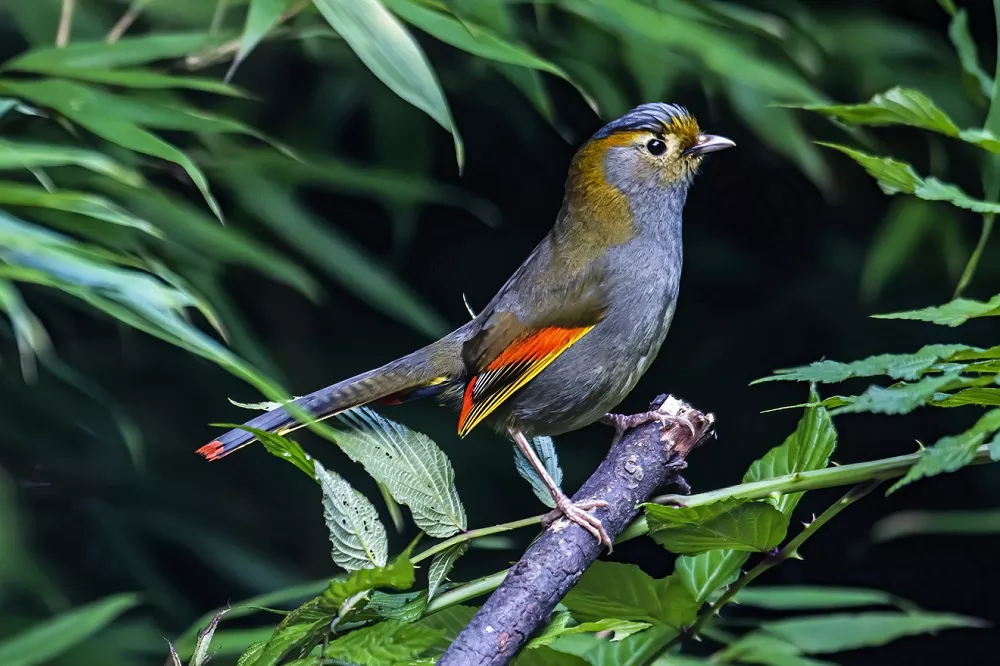The Emei Shan Liocichla (Liocichla omeiensis) is a captivating and enigmatic bird species that inhabits the lush forests of the Emei Mountain Range in southwestern China. With its striking plumage and elusive nature, the Emei Shan Liocichla has captured the attention of ornithologists and birdwatchers alike. This article delves into the characteristics, habitat, and conservation status of this remarkable thrush species.
Physical Description:
The Emei Shan Liocichla possesses an exquisite and eye-catching appearance that sets it apart from other thrush species.
Plumage: The bird’s plumage is a stunning combination of vibrant colors. Its head and upperparts display deep olive-green feathers, while the underparts are richly colored in a contrasting golden-yellow shade. The Emei Shan Liocichla’s wings are dark brown with prominent white wing bars, and its long tail feathers showcase a beautiful mix of chestnut and black.
Size: This species measures approximately 21-22 centimeters in length, with a relatively large, stout beak suited for its feeding habits.
Habitat and Distribution:
The Emei Shan Liocichla is endemic to the Emei Mountain Range, a UNESCO World Heritage site located in Sichuan Province, China. These mountains are renowned for their diverse and pristine forest ecosystems, which serve as the primary habitat for this species.
Forest Dweller: Emei Shan Liocichlas are predominantly found in the mountainous broadleaf and mixed forests of the Emei Mountain Range. They prefer the understory and mid-story levels of the forest, foraging among the dense vegetation and utilizing the forest structure for cover.
Geographic Range: The species’ distribution is limited to the high elevations of the Emei Mountain Range, primarily within the Emei Shan National Park. This restricted range adds to the mystique and conservation importance of the Emei Shan Liocichla.
Behavior and Conservation:
The Emei Shan Liocichla exhibits fascinating behaviors and faces specific conservation challenges.
Vocalization: The species is known for its melodious and variable song, which consists of a series of clear whistles and musical notes. Males sing to establish territories and attract mates, while both sexes use contact calls to communicate.
Elusive Nature: Emei Shan Liocichlas are known for their secretive behavior, often remaining hidden within the dense forest vegetation. This, coupled with their limited geographic range, makes studying and observing them a challenging endeavor.
Conservation Status: The Emei Shan Liocichla is classified as Near Threatened on the IUCN Red List of Threatened Species. Its small range and vulnerability to habitat loss due to deforestation and human activities pose significant conservation concerns. The establishment and management of protected areas, such as Emei Shan National Park, play a crucial role in the conservation of this species.
Conclusion:
The Emei Shan Liocichla is a captivating thrush species endemic to the Emei Mountain Range in southwestern China. Its stunning plumage, elusive behavior, and restricted geographic range make it a subject of fascination for bird enthusiasts and researchers. Efforts to protect and preserve the pristine forests of the Emei Mountain Range are vital for ensuring the long-term survival of the Emei Shan Liocichla and the preservation of its unique habitat. Through continued conservation efforts and research, we can deepen our understanding of this enigmatic species and contribute to its conservation for future generations to admire and appreciate.


 Facebook
Facebook  Instagram
Instagram  Youtube
Youtube 